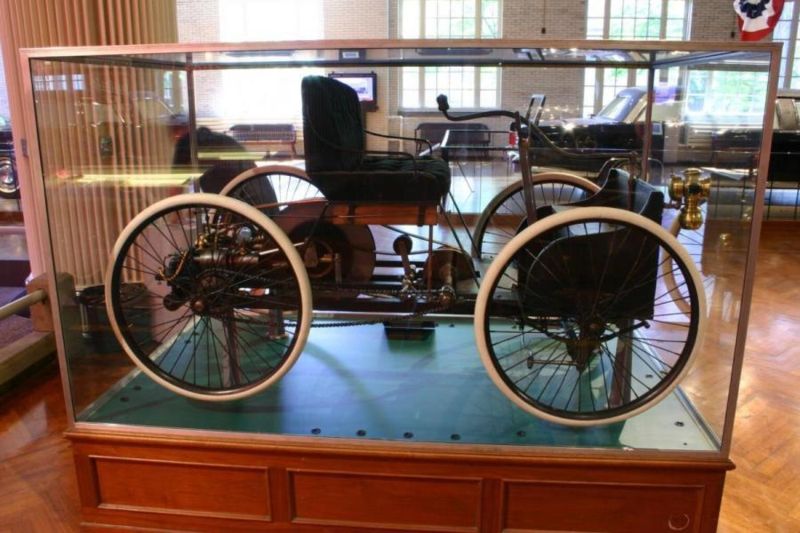The current quest for sustainable sources of energy comes from a critical awareness that the availability of fossil fuels is rapidly diminishing. Once used, fossil fuels have no further value. Unlike so many other things from the past, they're gone forever.
While George Santayana once claimed that "Those who cannot remember the past are condemned to repeat it," William Clay Ford had a different take on history.
"The further and faster the human race goes, the more difficult it becomes to remember its receding and ever-expanding past. To neglect that heritage is to risk a future in which young people find themselves without a means of building on the firm and reassuring foundation of the past."

An 1896 Ford Quadricycle on display at the Henry Ford Museum
(Photo courtesy of Wikipedia)
Had it not been for the zeal with which Ford's grandfather, Henry Ford, collected traces of America's Industrial Revolution, there might be little left to remind us of our not too distant history. Their pattern of display at the Henry Ford Museum in Dearborn, Michigan is vastly different from that seen in most other science museums. In Dearborn, visitors can observe minute changes in technology and design. The evolution of dictating equipment proves fascinating when compared to the technology of today's electronic office.
An indicator of the breadth of Henry Ford's collection is to note that, during the first few years of the museum's life, nearly 80% of its visitors could recognize and identify most of the objects on display from their personal experience. At best, no more than 5% of today's visitors can readily identify the same objects.
News that the wreck of the SS Gairsoppa had been discovered by Odyssey Marine Exploration (which had an exclusive search-and-salvage contract with the British government) gained international attention for one simple reason: The British merchant ship was carrying 7 million ingots of silver (now worth approximately $210 million) when it was torpedoed and sunk on February 16, 1941.
Anyone who routinely visits garage sales, flea markets, used clothing stores, or shops on eBay knows that there is hidden treasure to be found in recycling items that have gone out of fashion. In the following audio clip, Fanny Brice sings the "Second Hand Rose," a song she introduced during the Ziegfield Follies of 1921.
Whether souvenirs of the past were victims of planned obsolescence, passing fashions, or a death in the family, many have gained new life in the loving hands of people whose taste might be classified as "vintage" or "retro." Collectors often develop an insatiable appetite for such items.

An early desk stapler shown in the film, Unlikely Treasures
In a city with so much Victorian architecture, it's no surprise that many San Franciscans have developed an acute desire to become the curators of their own lives. Some like to spend their weekends "garage sailing" for items of interest (the fruits of their shopping adventures can often be seen at special costume events like the opening night of the San Francisco Silent Film Festival). Others have transformed their homes into miniature museums that cater to a highly specialized sense of style.
* * * * * * * * * *
A fascinating video clip about Adam Savage and Stanley Kubrick shows how the creative collector's mind can be driven by an artistic vision that others might misdiagnose as obsessive-compulsive disorder. And although budget problems forced the Philoctetes Center for The Multidisciplinary Study of Imagination to close its physical space and discontinue its programs, the organization's website and YouTube channel (which includes lengthy panel sessions devoted to "The Sensibility of the Collector" and "The Mind of the Collector") can still be accessed online.
What separates an organized hoarder from a collector with a more curatorial bent? The following video demonstrates how difficult it might be to find the answer.
No matter what a person likes to collect (wedding cake ornaments, miniature toy trains, dinosaur sculptures), anyone who has amassed a large collection of tchotchkes will instantly fall in love with a Canadian documentary entitled Unlikely Treasures. Written and directed by Tally Abecassis, this delightful indie gem should not be missed.

A woman stands before her collection of suitcases
It's hard to tell which part of this film is more fun: the collectors or their collections. Each has a story to tell which is more eccentric than the last. Some claim to have been born with "the collecting gene."
As Marilyn Gelfman-Karp explains: "I hear the call of objects all the time. They talk to me and say 'take me home!'" Marilyn is certainly no exception. Among the collectors featured in Unlikely Treasures are:
- Dorothy Globus, a curator at the New York Museum of Arts & Design, who has amassed all kinds of collections ranging from antique staplers to tea bags.
- Billy Mavreas, who owns a store in Montreal that displays old electronics manuals, swizzle sticks, and oh so much more.
- Kyle Supley, a "collecting savant" with a specialty in household electronics (ranging from 1960s clocks to wrist radios) as well as an occasional pair of high fashion platform shoes.
Viewers of Antiques Roadshow will especially like Abecassis's documentary, which includes a visit to a fascinating three-story home/museum in Greensboro, North Carolina that recycles collections into unique pieces of art, and the City Reliquary in Brooklyn.
At a mere 52 minutes in length, Unlikely Treasures contains more joy, curiosity, and appreciation of the past than you'll find in most films. By the time the final credits roll, many viewers will be grinning from ear to ear. Here's the trailer:
To read more of George Heymont go to My Cultural Landscape
